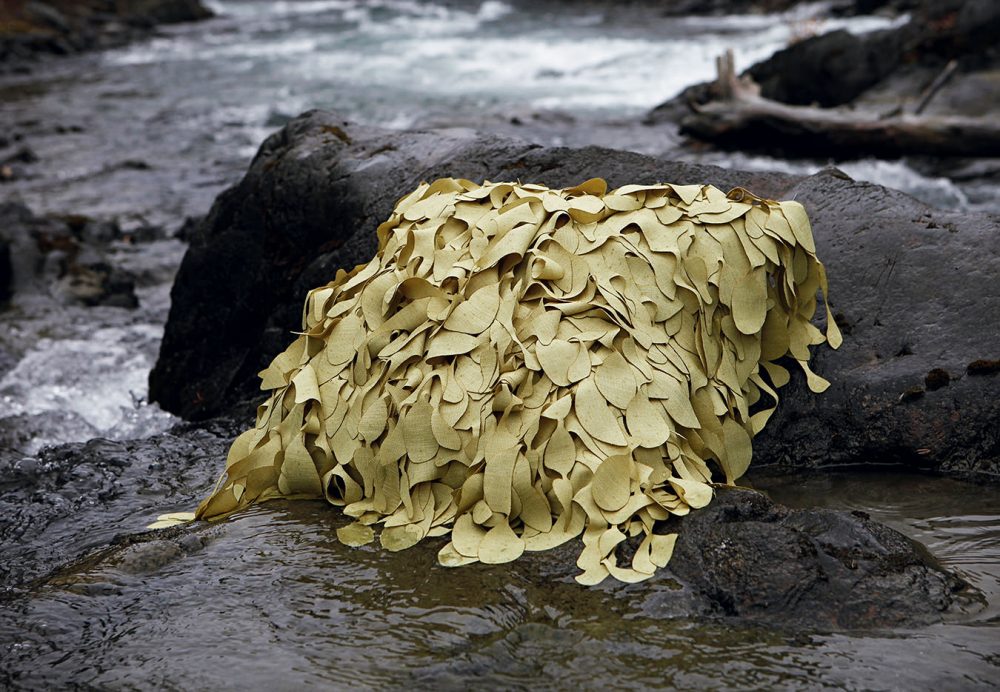Amongst a showroom of ball gowns and bedspreads in an industrial neighbourhood of Vancouver, the musky scent of caribou hide, slightly smoky and sweet, transports you for a moment. The small piece of skin, tanned by First Nations elders for fashion and home decor designer Catherine Regehr, is a relic of the wilderness. Its surface irregular and soft to the touch, the scrap of hide embodies the marriage of extremes embraced by the Vancouver-based designer.
From her second home in Atlin at the northernmost tip of British Columbia (just across the glacier field from Juneau, Alaska), Regehr is savouring springtime, taking advantage of the first thaw to revive her garden from an icy winter sleep. “It greatly increases my quality of life,” she says, referring to her northern retreat. The acclaimed designer was raised in Whitehorse, Yukon, where growing up, she embraced all that the untamed North could offer a curious eight-year-old. Although she was shipped off to boarding school as a teen, her formative years up north remain both an inspiration and an anchor.
Regehr later studied sculpture and painting at Emily Carr College of Art before moving to Paris, where she immersed herself in Parisian life and fashion design at L’École de la Chambre Syndicale de la Couture Parisienne. She made a stop in New York designing for Anne Klein and Bill Atkinson before returning to Vancouver in 1986.
A glance through Regehr’s home and couture collections offers a ready window to the frosty northern landscape: neutral tones, sumptuous textures, delicate ripple effects, even a design named after sea kelp. She dedicates a portion of each summer to a long canoe trip on one of the Yukon’s many rivers, and attributes much of her vision to these sojourns. Regehr describes the inspiration behind the pillow she recently created for Dior: “Late at night, when the water calms down, and there are little ripples in the water—repetitive patterns like this in nature inspire me to create textures. One thing will kind of feed the other thing. I may start with cushions for home and it will end up as the hem on a dress or a texture on a jacket.”
For as long as she has been designing, texture has been her focus. Her couture collection, launched upon her return to Vancouver in 1986, has always exuded a certain romance through its elegant, understated lines and luxurious silks. She likes simplicity, and likes even more that “people come back and say, ‘I’ve had this for 15 years,’ because I keep it timeless. Maybe I use a colour of the moment, but I try not to get into the trend of what’s now. My clients can do that with a Louboutin shoe.” Counted among those clients, by the way, are the likes of Kim Basinger, Carrie-Anne Moss, Anjelica Huston, and Bianca Jagger. Regehr’s dresses are as legitimate as ball gowns get; it’s impossible to wear one of her taffeta creations without sensing old Parisian glamour in every stitch.
Like the gowns, her cocktail dresses and separates emphasize a simple, wearable shape transformed by texture. She creates the samples herself, spending hours painstakingly pinning, for example, collar-to-hem petals on a dress she tells me we’ll see at the Room at the Bay later this summer.
The lines between her home and fashion collections are often blurry, but never so satisfyingly as in her recently launched caftans. She considers the caftans the “bridge” between her collections, and the designs sparked “one of those pivotal times in life.” She was at Market Week in Paris, and a man named Mohammed, claiming to represent three Saudi princesses, asked to see her caftan lookbook. “I don’t know why I let him have the line drawings,” she says now. “He could have been out to copy them for all I know.” But she realized he was on the up and up when he brought to her stand a striking woman with an impressive entourage, who promptly ordered, as Regehr says, “ ‘12 of these, 20 of those,’ whole crates in different colours.” The princess remains a loyal client and the caftans grow more elaborate each season.
Though the Yukon is a fixture in Regehr’s life and work, and she spends most summers there, the road back is long and winding. Her life leading up to this point has been a tug-of-war between the cities that engage her curiosity and the wilderness that claims her heart. This year alone she’s been to Paris twice already, and New York once, with periods spent in Vancouver in between. She escapes to her northern hideaway to “refresh, to pull out of that world and be in a polar-opposite environment,” she says. “I’m never happier than on a remote river, but I’m also very happy at La Fontaine de Mars in Paris. Anything in the middle just isn’t as interesting to me.”











